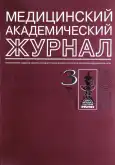Варианты биохимического ответа лимфоцитов на инфекционный процесс
- Авторы: Иванова В.В.1, Говорова Л.В.1, Тихомирова О.В.1
-
Учреждения:
- Научно-исследовательский институт детских инфекций
- Выпуск: Том 3, № 3 (2003)
- Страницы: 47-58
- Раздел: Фундаментальная медицина
- Статья опубликована: 31.08.2003
- URL: https://journals.eco-vector.com/MAJ/article/view/693604
- ID: 693604
Цитировать
Полный текст
Аннотация
На основании проводившихся в течение ряда лет исследований были выделены 3 основных варианта биохимического ответа организма на инфекционный процесс, обусловленных интенсивностью реакций перекисного окисления липидов (ПОЛ) в лимфоцитах:
1-й вариант - Угнетение процессов ПОЛ в лимфоцитах (ниже N-25, снижение уровня ДК в 2 раза), отсутствие бактерицидной защиты в достаточном объеме, несмотря на выраженную адаптационную активацию метаболизма (рост в 5-6 раз концентрации гормонов АКТГ, СТГ; циклических нуклеотидов в 2,5 раза), снижение уровня интерферона в крови, часто наблюдается развитие осложнений, наслоение вторичных бактериальных инфекций, хронизация процесса. АО терапия противопоказана.
2-й вариант - Активация ПОЛ в лимфоцитах в физиологически допустимых пределах (выше N+25, рост уровня ДК в 2-2,5 раза), обеспечение бактерицидного эффекта «дыхательного взрыва» в остром периоде заболевания, умеренная адаптационная активация метаболизма и интерфероногенеза; достаточно быстрый выход из болезни, без хронизации и развития осложнений. Может быть использована терапия витаминами-антиоксидантами двойного действия, такими как витамин C.
3-й вариант - Гиперактивация процессов ПОЛ в лимфоцитах (ДК значительно выше нормы, >4 N, рост уровня ДК в 8-10 раз), что свидетельствует о развитии патологических нарушений ПОЛ, сопровождается значительными сдвигами биохимических характеристик, повреждением мембранных структур, угнетением интерфероногенеза: развитием суперинфекции, тяжелыми воспалительными осложнениями, интоксикациями, неблагоприятным прогнозом течения инфекционного процесса. Этим больным показана АО терапия.
Ключевые слова
Об авторах
В. В. Иванова
Научно-исследовательский институт детских инфекций
Автор, ответственный за переписку.
Email: shabanov@mail.rcom.ru
Член-корреспондент РАМН
Россия, 197022, Санкт-Петербург, ул. Попова, 9Л. В. Говорова
Научно-исследовательский институт детских инфекций
Email: shabanov@mail.rcom.ru
Россия, 197022, Санкт-Петербург, ул. Попова, 9
О. В. Тихомирова
Научно-исследовательский институт детских инфекций
Email: shabanov@mail.rcom.ru
Россия, 197022, Санкт-Петербург, ул. Попова, 9
Список литературы
- Вельтищев Ю. Е., Ермолаев М. В., Ананенко А. А. и др. Обмен веществ у детей. М.: Медицина, 1983.
- Владимиров Ю. А. Патологическая физиология. СПб., 1989. С. 7-19.
- Гамалей И. А., Клюбин И. В., Арнаутова И. П., Кирпичникова К М. Пострецепторное образование активных форм кислорода в клетках, не являющихся профессиональными фагоцитами // Цитология. 1999. Т. 41. № 5. С. 394-399.
- Говорова Л. В., Буловская Л. И. Метаболическая адаптация лимфоцитов при инфекционном процессе // Современные проблемы детской инфектологии. М., 1997. С. 151-155.
- Говорова Л. В. Механизмы метаболической адаптации и окислительный стресс при вирусных и бактериальных инфекциях у детей: Автореф. докт. дис. СПб., 2002. 48 с.
- Журавлев А. И. Свободнорадикальная патология // Биоантиокислители в регуляции метаболизма в норме и при патологии. М.: Наука, 1982. С. 7-8.
- Дубинина Е. Е. Активные формы кислорода и их роль в развитии оксидативного стресса //Фундаментальные и прикладные аспекты современной биохимии / Под ред. И. Г. Щербака. СПб.: Изд-во СПбГМУ, 1998. С. 386-398.
- Дубинина Е. Е. Роль активных форм кислорода в качестве сигнальных молекул в метаболизме тканей при состояниях окислительного стресса //Вопр. мед. химии. 2001. Т. 47. № 6. С. 561-581.
- Иванова В. В., Говорова Л. В., Лукина В. В. и др. Характеристика липидного состава, интенсивности перекисного окисления липидов и АТФазной активности лимфоцитов // Вопр. мед. химии. 1987. № 2. С. 132-136.
- Иванова В. В., Говорова Л. В., Тихомирова О. В. Применение витаминов антиоксидантного действия, коррекция процессов перекисного окисления липидов у детей при ОРВИ // Детские инфекции. СПб., 1991. Вып. 3. С. 45-54.
- Козлов ТО. 77. Свободнорадикальное окисление липидов в биологических мембранах в норме и при патологии // Биоантиокислители. М.: Наука, 1975. С. 5-14.
- Таранова Н. П., Говорова Л. В. Способ определения суммарных липидов в лимфоцитах периферической крови // Вопр. мед. химии. 1987. № 2. С. 132-136.
- Чуканин И. Н., Иллек Я. Ю., Мухаммедов С. 3. Показатели энергетического обмена при бронхопневмонии у детей раннего возраста // Мед. журн. Узбекистана. 1985. № 2. С. 4-6.
- Урбах В. Ю. Математическая статистика для биологов и медиков. М., 1963.
- Юрков Ю. А., Банкова В. В., Хамидова М. М. и др. Свободнорадикальное окисление липидов и устойчивость к гемолизу эритроцитов здоровых и больных детей // Вопр. мед. химии. 1984. № 4. С. 101-106.
- Ярош А. М. Перекисное окисление липидов при воспалении легких //Бюл. эксп. биол. и мед. 1984. Т. ХСУП. № 4. С. 486-488.
- Brown-Borg H. M., Bode H. M., Bartke А. Antioxidative mechanisms and plasma growph hormone levels: potential relationship in the aging process // Endocrine. 1999. Vol. 11. № 1. P. 41-48.
- Bucher Y. R., Roberts R. Y. // Pediatr. Res. 1981. Vol. 15. № 7. P. 999-1008.
- Dandona P., Suri M., Hamouda W. et al. Hydrocortisone-induced inhibition of reactive oxygen species by polymorphonuclear neutrophils // Crit. Care Medicine. 1999. Vol. 27. №11. P. 2442-2449.
- Fridovich Y. Superoxide dismutases // Adv. Ensym. 1974. Vol. 41. P. 35-97.
- Folch J. M., Lees G. N., Sloune-Stenley G. // J. Biol. Chem. 1973. Vol. 226. P. 447-502.
- Nakao T., Tashima Y., Nagano K., Nakao M. Highly specific sodium-potassium activated adenosine-triphosphatase from various tissues of rabbit // Biochem. biophys. Res. Commun. 1965. № 19. P. 755.
Дополнительные файлы






